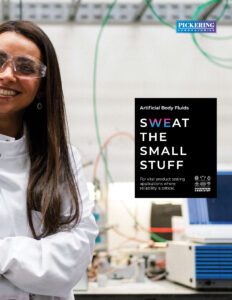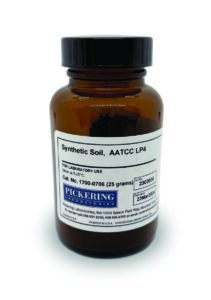Polyether Antibiotics are commonly used for preventing coccidiosis and other infections in poultry and for improving feed efficiency for beef cattle and swine. The use of Polyether Antibiotics is strictly regulated, with only specific ionophores approved for use in feeds intended for different animals.
Analysis of Polyether Antibiotics by HPLC with post-column derivatization and UV/Vis detection has been proven to successfully identify and quantify Monensin, Narasin and Salinomycin in medicated feeds, supplements and premixes as well as to determine trace contamination levels in non-medicated feeds.
Post-column derivatization of Polyether Antibiotics is done using highly acidic Vanillin or DMAB reagents. The Onyx PCX derivatization system (Pickering Laboratories, Inc.) has an inert flow path and automated system wash capabilities that make it uniquely suitable for handling corrosive reagents. The two-pump system is recommended to extend reagent stability, but the single-pump system for this application is also available.
Adding a Fluorescence detector to the instrumentation allows for using the same extraction procedure and HPLC conditions to also determine Lasalocid, which doesn’t require post-column derivatization.
The method details can be found on our website here.
The typical flow diagram for the Polyether Antibiotics post-column system is shown here:

Good Chromatogram:

Bad Chromatogram:

What could be contributing to the loss of signal?
Submit your answers to rsmith@pickeringlabs.com by Friday, September 1, 2023.
Pickering Laboratories would like to congratulate the winners for our previous newsletter’s Chromatography Quiz #42:
 Thomas Schneider from SCWA, Narjes Ghafoori from Los Angeles County Public Health Laboratory, and Josiah Hakala from Minnesota Department of Health.
Thomas Schneider from SCWA, Narjes Ghafoori from Los Angeles County Public Health Laboratory, and Josiah Hakala from Minnesota Department of Health.
They each will soon be receiving a Nike $100 Gift Card!
Congratulations to our quiz winners! Thank you all for your submissions!
Chromatography Quiz #42 Solution:
Natural human perspiration has a complex composition that depends on the type of sweat gland, the person’s metabolism and hydration level. Pickering Laboratories’ human mimic artificial perspiration solutions are formulated based on published data for human sweat and provide the closest match to the “real thing” available on the market. These solutions are perfect for testing a variety of consumer products and medical devices as well as for forensics applications and as blanks for medical testing protocols.
- There are two types of human perspiration; Eccrine and Apocrine
- Eccrine perspiration is used for body temperature regulation.
- Eccrine perspiration contains amino acids, minerals, and metabolites.
- Pickering Laboratories’ proprietary Artificial Eccrine Perspiration comes at pH 5.
- Apocrine perspiration is secreted by apocrine glands and contains fatty acids and proteins.
- Apocrine perspiration is initially odorless. Odor (volatile fatty acids) is produced once acted upon by bacteria.
- What is an oily substance that mixes with lipids to form a protective coating on the skins surface?
- Sebum
- Cerumen
- Perspiration
- All of the above
- Currently, Pickering Laboratories offers the following product testing solutions:
- Perspiration
- Blood
- Saliva
- Lung Fluid
- All of the above
- The pH of the solution is an important consideration in product testing, affecting corrosion rate, level of color degradation and leaching of metals and organic components from wearable products. Many procedures require a tight pH range during testing. To accommodate these pH requirements and to improve pH stability over time, Pickering Laboratories is offering buffered versions of industry-specific artificial perspiration formulations. By adding a Phosphate buffer to the original formulation, the pH stability of the solution is greatly improved while its effect on corrosion and colorfastness remains unaffected.
- _____________ is one of the most important concerns in the textile industry. Discoloration of fabric can be due to perspiration, light, rubbing or a combination of all three. Salt, urea and lactic acid present in sweat can disrupt the bonding that dyes form with the fabric fibers, causing fading of the color. In addition, amino acids in sweat can attach to fabric to produce “protein stains”.
- Dissolution
- Staining
- Corrosion
- Colorfastness
- Use of nanotechnology to endow new properties to textiles, such as antibacterial or UV protection, water repellency or flame retardancy, together with incorporating sensors and other digital components, creates the need to consider the effects of sweat on nanoparticles leaching and _____________ of integrated circuits as well.
- Corrosion
- Rusting
- Colorfastness
- Dissolution
- A Certificate of Analysis (COA) and Safety Data Sheet (SDS) are available for all product testing solutions at no additional charge. True
- Pickering’s product testing solutions and mimics are convenient, save you time, homogenous, reproducible, and customizable. True
- Pickering offers customizable versions of our product testing formulations. True
- Pickering Labs will be at booth 2138 at Pittcon 2023. True


 The Onyx PCX post-column derivatization instrument is designed for highly customizable Amino Acid Analysis, using our expertise in post-column technology to bring high performance when used alongside any manufacturer’s HPLC. Pickering Laboratories provides a complete application solution, guaranteeing the chromatogram of any customer using our instrumentation and consumables, regardless of sample matrix. We at Pickering Laboratories recommend the Onyx post-column system with one of our available Amino Acid Application Kits for any new user starting a new analysis in their laboratory.
The Onyx PCX post-column derivatization instrument is designed for highly customizable Amino Acid Analysis, using our expertise in post-column technology to bring high performance when used alongside any manufacturer’s HPLC. Pickering Laboratories provides a complete application solution, guaranteeing the chromatogram of any customer using our instrumentation and consumables, regardless of sample matrix. We at Pickering Laboratories recommend the Onyx post-column system with one of our available Amino Acid Application Kits for any new user starting a new analysis in their laboratory. 





 Thomas Schneider from SCWA, Narjes Ghafoori from Los Angeles County Public Health Laboratory, and Josiah Hakala from Minnesota Department of Health.
Thomas Schneider from SCWA, Narjes Ghafoori from Los Angeles County Public Health Laboratory, and Josiah Hakala from Minnesota Department of Health.  Synthetic soil is used as the soiling option for evaluations of stain and soiling related to pile yarn floor coverings. The official methods that are used for these evaluations are AATCC TM122, AATCCTM123 and ASTM D6540. The procedure to apply the test soil is being improved to make it reproducible, and this has changed the status of some of the methods. Regardless, the synthetic soil used to soil or stain the floor covering has remained the same. The ingredients used and the procedure for formulating the synthetic soil is now available as AATCC LP4-2023. The Pickering Laboratories Synthetic soil (1700-0706) follows this procedure, sieved using 200 mesh sieve and is available in 25 g quantities. This formulation can also be used in other product testing procedures that require the use of synthetic soil.
Synthetic soil is used as the soiling option for evaluations of stain and soiling related to pile yarn floor coverings. The official methods that are used for these evaluations are AATCC TM122, AATCCTM123 and ASTM D6540. The procedure to apply the test soil is being improved to make it reproducible, and this has changed the status of some of the methods. Regardless, the synthetic soil used to soil or stain the floor covering has remained the same. The ingredients used and the procedure for formulating the synthetic soil is now available as AATCC LP4-2023. The Pickering Laboratories Synthetic soil (1700-0706) follows this procedure, sieved using 200 mesh sieve and is available in 25 g quantities. This formulation can also be used in other product testing procedures that require the use of synthetic soil.